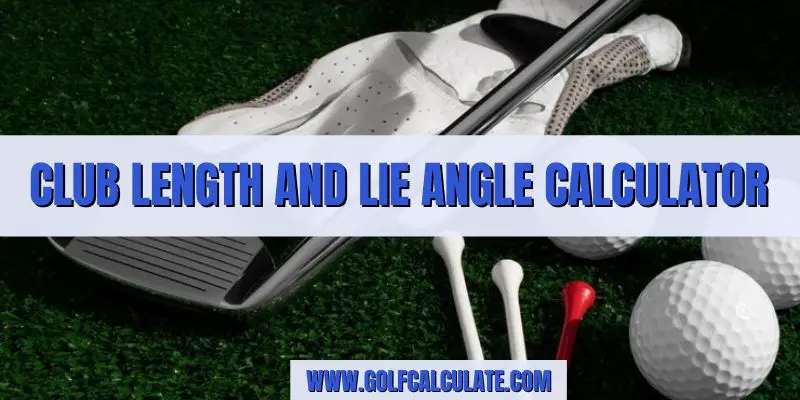In golf, the “Length” of a golf club refers to the measurement from the top of the grip to the bottom of the clubhead. Longer clubs typically hit the ball farther, while shorter clubs offer more control and accuracy. The length of a club can vary depending on the golfer’s height, arm length, and swing characteristics.
The “Lie Angle” of a golf club refers to the angle formed between the club shaft and the ground when the sole of the club is flat on the ground. It influences how the club interacts with the turf at impact and can affect the direction the ball travels. A lie angle that is too upright can cause the ball to go left for a right-handed golfer, while a lie angle that is too flat can cause the ball to go right.
Both the length and lie angle of golf clubs are important factors in ensuring that the clubs are properly fitted to a golfer’s physical characteristics and swing mechanics, which can ultimately affect performance on the course. Professional golfers often go through custom club fitting processes to ensure that their clubs are optimized for their individual needs.
Club Length and Lie Angle Calculator
How This Calculator Works?
This calculator determines the lie angle of a golf club based on the shaft length and the ground distance to the clubhead. The lie angle is the angle between the shaft and the ground when the club is at address. It's an important factor in fitting clubs to a player's swing to ensure optimal performance.
The formula used in this calculator is:
$\text{Lie Angle} = \arctan\left(\frac{\text{Ground Distance}}{\text{Shaft Length}}\right) \times \frac{180}{\pi}$
Let's break it down:
- $\text{Shaft Length}$ is the length of the golf club shaft in inches.
- $\text{Ground Distance}$ is the distance from the ground to the clubhead in inches.
- $\arctan$ is the inverse tangent function, also known as the arctangent or the inverse of the tangent function. It's used to find the angle whose tangent is a given number.
- $\frac{180}{\pi}$ is a conversion factor to convert the angle from radians to degrees since the result of the arctangent function is in radians.
Here's an example:
Let's say the shaft length is 43 inches and the ground distance to the clubhead is 1.5 inches.
Using the formula:
$\text{Lie Angle} = \arctan\left(\frac{1.543}{1}\right) \times \frac{180}{\pi}$
Calculating:
\[ \begin{align*} \text{Lie Angle} &\approx \arctan(0.03488) \times \frac{180}{\pi} \\ \text{Lie Angle} &\approx (1.99^\circ) \times \frac{180}{\pi} \\ \text{Lie Angle} &\approx 114.09^\circ \end{align*} \]
So, the lie angle of the golf club would be approximately 114.09∘114.09^\circ114.09∘.
Make sure to convert the angle from radians to degrees as the final result.
How to Calculate Club Length and Lie Angle?
Calculating golf club length and lie angle involves several steps and considerations to ensure proper club fitting for an individual golfer. Here's a general guide on how to calculate club length and lie angle:
1. Measure Wrist-to-Floor Distance: This measurement helps determine the starting point for club length calculation. Stand in a comfortable golfing posture, and measure the distance from your wrist to the floor.
2. Measure Height: Measure your overall height in inches. This measurement is essential for determining the proportion of the club length relative to your height.
3. Determine Club Length: Use a fitting chart or formula provided by golf club manufacturers or professional club fitters to estimate the appropriate club length based on your height and wrist-to-floor measurement.
Some fitting methods may involve adding the wrist-to-floor measurement to a portion of your height to determine the club length.
4. Consider Swing Characteristics: Assess your swing characteristics, including swing speed, swing plane, and attack angle. These factors can influence the optimal club length for your swing.
5. Consult Manufacturer Recommendations: Many golf club manufacturers provide fitting charts or online fitting tools based on height and wrist-to-floor measurements.
These tools offer general recommendations for club length based on standardized fitting guidelines.
6. Calculate Lie Angle: Lie angle is the angle between the club shaft and the ground when the club is in a standard address position. It affects how the club interacts with the turf and impacts shot direction and ball flight.
Lie angle is typically measured in degrees. The ideal lie angle depends on factors such as the golfer's height, posture, swing plane, and impact position.
Lie angle can be adjusted by bending the club's hosel (the part of the club where the shaft attaches to the clubhead) up or down.
Professional club fitters use lie angle machines to accurately adjust lie angles based on a golfer's swing characteristics.
7. Perform Dynamic Fitting: Dynamic fitting involves observing your swing characteristics and ball flight patterns using various club lengths and lie angles to determine the best fit. It often requires the assistance of a professional club fitter or coach.
8. Test and Adjust: After calculating club length and lie angle, it's essential to test different club configurations to find the most comfortable and effective fit for your swing.
Experiment with different lengths and lie angles on the driving range or with the help of a professional club fitter to fine-tune your equipment.
9. Regular Evaluation: As your swing evolves and your game improves, it's essential to periodically reassess your club length and lie angle to ensure they continue to suit your needs and playing style.
By following these steps and considering various factors, you can calculate and determine the most suitable club length and lie angle for your game. For precise fitting and personalized recommendations, consulting with a professional club fitter or coach is recommended.
